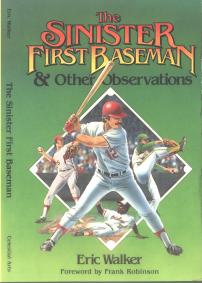“
Experto credite” (“Trust one who has proved it.”)
–
Aeneid,
Publius Vergilius Maro (Virgil)

(Although the editorial “we” is used throughout on this site, it is in fact a one-man operation. Till recently, I have been rather evasive, not because I’m naturally modest but precisely because I am not, and a resumé—always a difficult balancing act between modesty and vanity—is a place where it is easy to go astray. But I’ve decided to heed Sherlock Holmes’ admonition to Dr. Watson: “To the logician all things should be seen exactly as they are, and to underestimate one’s self is as much a departure from truth as to exaggerate one’s own powers.” I thus finally say some few things about myself.)
“Eric Walker, the most important baseball thinker you have never heard of.”
— George F. Will,
The New York Times
The Short Resumé
My name is Eric Walker. I have a degree in engineering (electrical) from Rensselaer Polytechnic Institute.
Something now approaching a half-century ago, in the later 1970s, I began an intensive study of baseball that I still pursue. That study was twofold: theoretical analysis using the mathematical techniques described throughout this site, and practical, meaning spending hours virtually every day down in major-league clubhouses, dugouts, press boxes, and front offices. To manage that second part, I drew on prior experience in radio broadcasting and made myself into a duly credentialed sports journalist. Based in the San Francisco Bay Area, I had daily access to two teams (and thus both leagues), meaning a home game to cover almost every day.
I soon came to have a daily five-minute “module” on baseball that was syndicated to interested public-radio stations around the country; during its heyday, it was carried on about two dozen stations, roughly half in what the trade calls “major markets”. I also did the occasional free-lance magazine piece.

In 1982, my book The Sinister First Baseman and Other Observations, a diverse collection of essays on baseball (actually written in 1981), was published; Hall-of-Famer Frank Robinson (then manager of the San Francisco Giants) was kind enough to write the foreword to that book, whose cover you can see at the right.
Meanwhile, my theoretical studies (based originally on the pioneering work of the now-underappreciated Earnshaw Cook) had advanced to the point where I felt they were capable of practical use by a ball club. In the 1980s, the San Francisco Giants took me on as a consultant.
Soon after Frank Robinson left the Giants, so did I. Shortly thereafter, I was taken on by the Oakland Athletics, in particular by then-GM Sandy Alderson, to whom I subsequently reported direct. I remained on contract with the Athletics from then till I moved out of California in the late 1990s.
When Billy Beane was appointed AGM of the Athletics, Sandy asked that I prepare some material for Billy that would explain what I do and, in the larger sense, explain to Billy the A’s front-office philosophy, which was largely based on the analytic approach. Billy subsequently remarked (to Michael Lewis, author of Moneyball) that in reading that report it was as if the scales fell from his eyes (those words are as Michael reported them back to me). I do know that Billy subsequently had that report copied and sent out to all of the A’s minor-league staff and scouts as an explanation of the A’s philosophy.
(I am, to be honest, not happy with the discussion in Moneyball; I don’t think a somewhat technical 62-page report is well described by the term “pamphlet”, and there is little or nothing in the book to suggest that I ever did anything for the A’s beyond prepare that one document. Sigh. That, I suppose, is what comes of keeping a low profile. See the aptly titled article “The Forgotten Man of Moneyball” at Deadspin.)
There is another history in which much more discussion of that period appears, Alan Schwarz’s book The Numbers Game; Alan was rather kinder in evaluating my role. I do think it is neither vain nor exaggerating to say that I had a large share in establishing the principles by which the A’s reached the immense success they did—as documented in Moneyball—and which success has in turn spawned other progressive front offices whose impact is now being felt. Put more simply, I think I have, in my modest way, helped transform the game.
(Let me be clear that I was neither the first nor the last analyst employed by a major-league club, and most of the others have been exceedingly well-qualified people who have contributed much to the field, among them Eddie Epstein, Craig Wright, Bill James, and Tom Tango; but I was, I think, the one who had the good fortune to be in the right place at the right time—a sympathetic and intelligent front office—to have an enduring effect.)
Return to the page top. ↑
The Longer Version
Prior to Baseball
I was born and raised in New York City. I attended the Bronx High School of Science, then took a degree in electrical engineering at Rensselaer Polytechnic Institute.
After college, I worked for a few years in the aerospace industry designing award-winning satellite and spacecraft systems, then got tired of being a white shirt, and so went into broadcasting (I had done college radio and had worked as a studio and news engineer at a major New York City station during my college summers). I started as a DJ, then acquired a telephone-talk show on a medium-sized radio station in the northern-Virginia suburbs of Washington, D.C. Then I moved over to one of the only two AM “underground rock” (as it was then styled) radio stations in America, a place where we got hand-delivered copies of the first release by an then-unknown named Elton John. Eventually I got tired of east-coast weather, so I and my lady—whom I had met while in Virginia—just picked up one day and drove off to San Francisco.
(As you will see, we frequently got tired of this or that and just jumped into something new; we like the phrase from one of Alexei Panshin’s novels, describing an old vaudeville couple, Pickles and Daisy: “They made life up as they went along.”)
In San Francisco, I did the usual strange variety of things that seem necessary for anyone who will ever have a book published (so as to provide interesting jacket copy): I sold meat in bulk over the telephone, I managed a luxury apartment building on Telegraph Hill, I wrote internal procedural manuals for banks, and suchlike odd things—even put in the mandatory spell as a taxicab driver.
In 1977, with the probable sale of the San Francisco Giants to Toronto looming (which, of course, in the end never happened), my lady suggested that we catch a few games while we still had the chance. I had had a mild and passing interest in baseball in my early youth, but none since; she, though, had been a diehard Washington Senators fan (“Washington: first in war, first in peace, last in the American League”). But it sounded like good, clean, all-American fun, so we indeed went.
I was immediately captivated. But I was also immensely curious about the inner workings of the game. I had all the questions that have kept saloon conversations going for over a century: is power worth more or less than batting average? How important are stolen bases? Well, you know the routine.
I did a few preliminary numerical doodles, then decided it would be silly to re-invent the wheel, so I went to the main library branch to try to find out if anyone had as yet invented that wheel (I had dim memories of Branch Rickey’s famous 1954 mathematical attempt at baseball analysis). I stumbled across what, if this were a Reader’s Digest article, I’d probably call The Book That Changed My Life.
Return to the page top. ↑
My Baseball Education
The “short-form” resumé above covers much of the ground here. Earnshaw Cook’s wonderful book Percentage Baseball (and its successors) started me off, and I have built on that foundation ever since. I have made some advances that I think are mainly or wholly my own, such as recognizing the “compound interest” effect of on-base percentage and the status of the batter as a “runner at base zero”, and in the area of team-fielding analysis (though that has now been duplicated by others). There are a couple of other things, at least one being extremely important, that I will not set forth here in case I ever decide to go back into actual consulting.

It has been a long march, from seemingly endless yellow legal pads covered with a gazillion hand-entered, hand-made calculations, to a “luggable” (not truly “portable”!) Kaypro computer (shown at the right), to a modern PC (which will doubtless sound in a few years as comically antique as that Kaypro does today); from ineffably tedious manual keyboarding (and checking, and re-checking, and re-re-checking) of annual stats—major-league and minor-league—to nowadays downloading tons of raw data anew every night. There is still a lot to do, even just on this one site, and I hope to always be expanding what is here, but we’ll see what we’ll see. I do have other interests.
Return to the page top. ↑
An Internet Bibliography
I have provided, on a separate page, a collection of links related to my baseball work. I got it by simply using Google; so far as I know, it is—within the bounds stated there—complete, but I may well have missed things.
Return to the page top. ↑